Preparing Container Roses for Spring
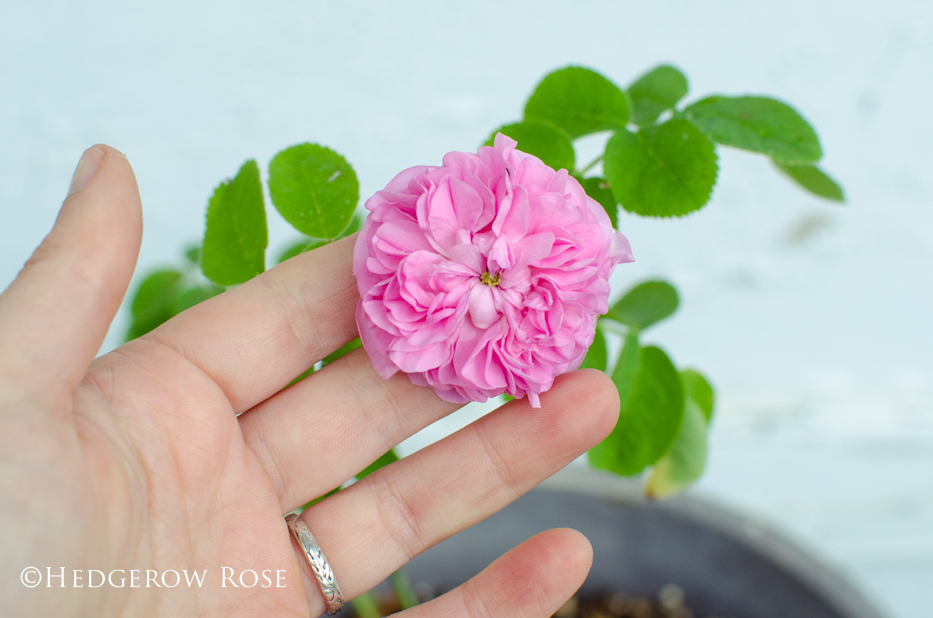
The other day I was thinking about how we, as gardeners, all have peculiar little rituals we perform every year to prepare our garden for spring and the upcoming growing season. And with the exception of those extremists who wage chemical warfare in the yard every year, I don’t think there is a right or wrong way to go about it. We’ve found what works best for us, right?
Every spring, I look forward to the day when the weather has settled down (for the most part), and it’s warm enough to spend some time outdoors “waking up the roses.” It’s truly one of the most pleasant interludes I spend in my garden all season, perhaps because I’ve spent the long winter months waiting for it. This year, we’ve had one of the wonkiest late winters/early springs I can remember, so my roses woke up before they were supposed to and subsequently had much of their tender new growth burned off by frost. However, I think things have returned to some semblance of normalcy, so yesterday I spent the gorgeously sunny afternoon truly preparing for them for the summer months. Most of my roses are in containers, but what I’ve done here could also apply to roses in-ground. Here’s my early spring ritual, what’s yours?

OK, so first, things first. My time in the garden is total ME time, so I like to make the most of it and bring something refreshing outside with me. This spring, I’m all about iced coffee. Can’t get enough of it.
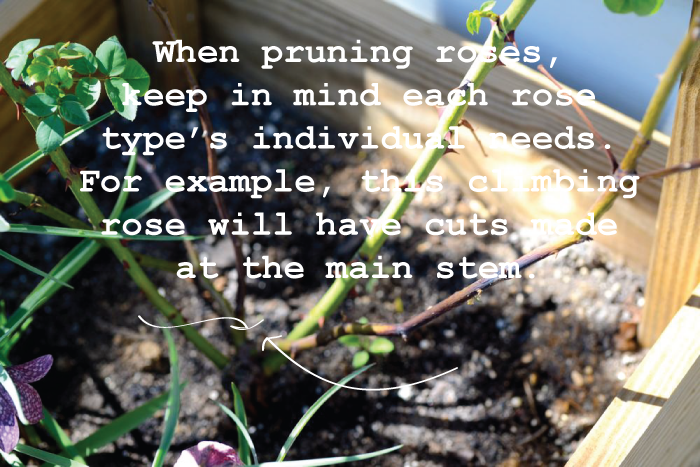
To start things off, I grab my rusty trusty Felcos and make my pruning cuts. Over the years I’ve become less and less of a pruner. So much so that I wonder if when I’m older I won’t make the cuts at all, but I do follow some basics:
1. Remove any deadwood and non-productive canes
2. Remove canes that are crossing/rubbing one another
3. Remove any suckers (from BELOW the bud union)
When it comes to my OGR’s, ramblers and my climbers I pretty much leave them alone unless they absolutely need some pruning (see example above). My Austin’s, floribundas and other shrub roses I may prune back by about 1/3 and my Hybrid Teas I prune the most, by about 2/3. I make my cuts where there is an outward facing bud, and though I joke about my Felcos being rusty, it is really important to make sure your pruners are sharp to avoid a ragged edge which just invites disease. Some gardeners don’t bother with the 45 degree angle rule for their cuts, but it’s habit for me so I continue. I know I’m probably forgetting something, but that’s basically the gist of it.
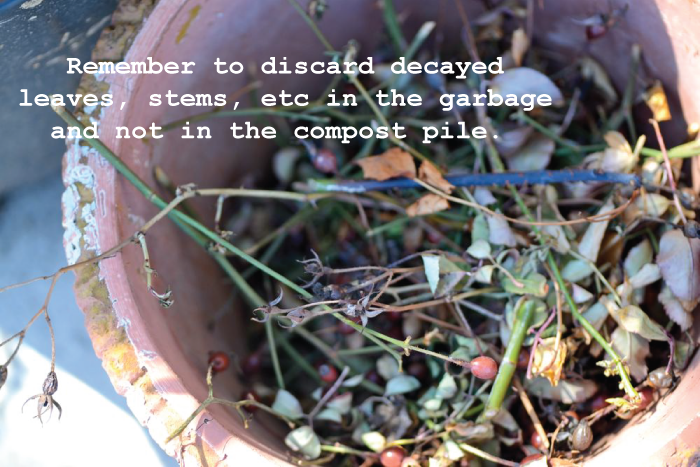 Following that, I make sure to clean up any debris that may have dropped off over winter (or was missed during the fall cleanup). This is easy-peasy for my container roses because I just sweep up with my hands. I also weed out any little seedlings that are sprouting up, too. Debris, such as leaves and canes should be thrown out, not composted, just in case they’re harboring disease.
Following that, I make sure to clean up any debris that may have dropped off over winter (or was missed during the fall cleanup). This is easy-peasy for my container roses because I just sweep up with my hands. I also weed out any little seedlings that are sprouting up, too. Debris, such as leaves and canes should be thrown out, not composted, just in case they’re harboring disease.
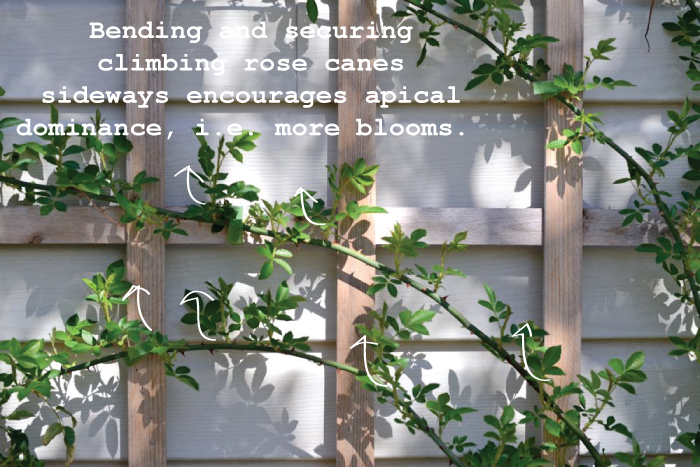 After my pruning and cleanup is done, I have a better idea of who needs staking and tying. The canes are nice and supple and still coming out of dormancy so it’s a good time to tie up climbers, peg down arching canes, etc.
After my pruning and cleanup is done, I have a better idea of who needs staking and tying. The canes are nice and supple and still coming out of dormancy so it’s a good time to tie up climbers, peg down arching canes, etc.
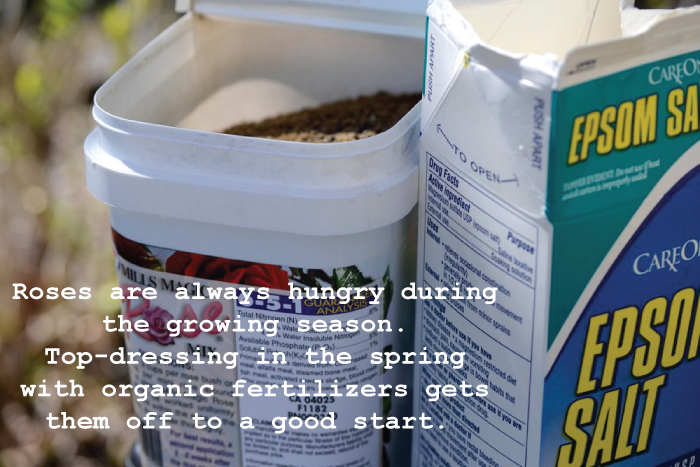 Once that’s done, I top-dress all of my roses with some organic fertilizers and epsom salts. In the past, I would buy all of my fertilizers (blood meal, bone meal, fish meal, cottonseed meal) individually. This year, I am trying Mills Magic Mix which has a “combination of alfalfa meal, fish meal, steamed bone meal, cottonseed meal, blood meal, activated sludge, and an organic compost activator” all in one. Hooray for convenience! I also sprinkle a couple tablespoons of epsom salts on my roses, too, for the magnesium. Now, they say to scratch these fertilizers into the top of the soil, but I never do because I don’t want to damage the delicate feeder roots. Instead, I scatter them around the base and dripline of the roses and then go to the next step…
Once that’s done, I top-dress all of my roses with some organic fertilizers and epsom salts. In the past, I would buy all of my fertilizers (blood meal, bone meal, fish meal, cottonseed meal) individually. This year, I am trying Mills Magic Mix which has a “combination of alfalfa meal, fish meal, steamed bone meal, cottonseed meal, blood meal, activated sludge, and an organic compost activator” all in one. Hooray for convenience! I also sprinkle a couple tablespoons of epsom salts on my roses, too, for the magnesium. Now, they say to scratch these fertilizers into the top of the soil, but I never do because I don’t want to damage the delicate feeder roots. Instead, I scatter them around the base and dripline of the roses and then go to the next step…
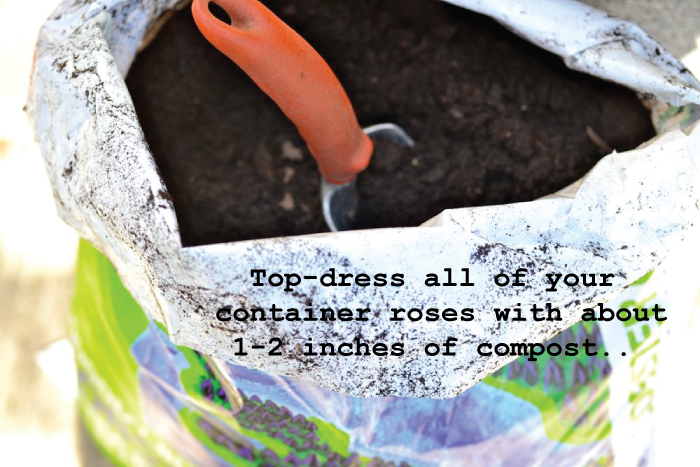
All of my roses (and all of my container plants for that matter) get a healthy top-dressing of compost which I pile up on top of the fertilizers. Since I used composted cow manure when I planted them, I like to mix it up and give them a different kind of compost when I top dress them. Variety is key, I think. Personally, I love the Coast of Maine Lobster Compost, but it is very pricey. Since I only put a couple of inches down on each, I splurge.

Sprinkle sprinkle!
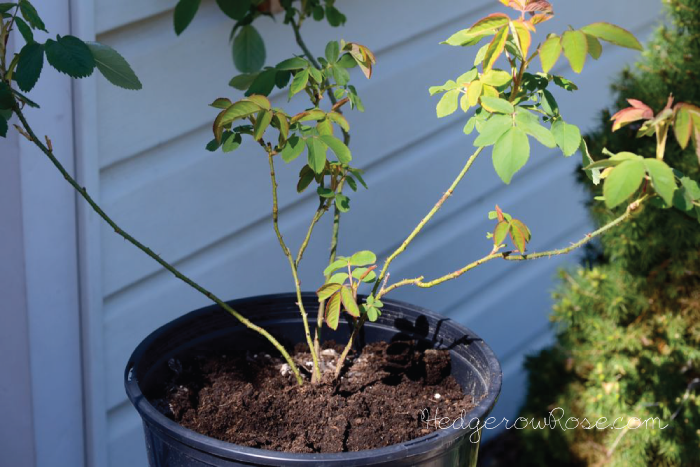 Everybody gets the business, large or small. Even ‘Comte de Chambord’ in her tiny home got a dose of fertilizers and a top dressing of lobster compost. Lucky little rose.
Everybody gets the business, large or small. Even ‘Comte de Chambord’ in her tiny home got a dose of fertilizers and a top dressing of lobster compost. Lucky little rose.
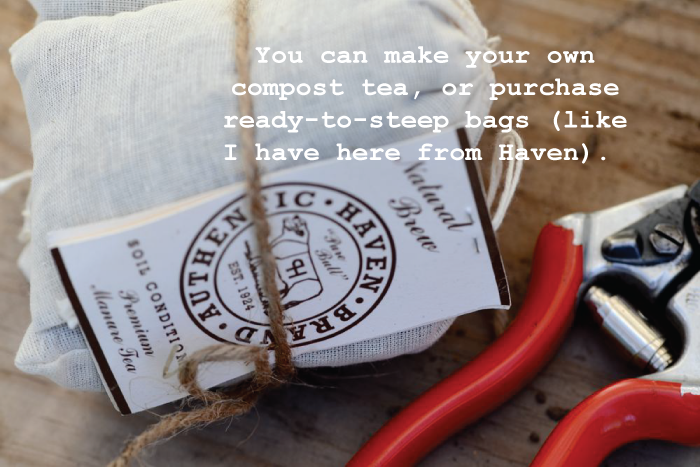 Last, I water in all the amendments I’ve just added using the compost and alfalfa tea I’ve been steeping for a couple of days just for this occasion. You can make your own, or buy pre-made bags like I do.
Last, I water in all the amendments I’ve just added using the compost and alfalfa tea I’ve been steeping for a couple of days just for this occasion. You can make your own, or buy pre-made bags like I do.
In just a couple of months, these roses will be putting forth blooms to bring into the home, enjoy in the garden and share with friends. This little extra time it takes to prepare them for the growing and blooming season is worth the effort. Such a small thing for such a large reward!

I love this post! It makes me miss the beautiful container garden I once had – I’m inspired to perhaps start another one! Your blog is great.
Oh thank you so much! I definitely think you should start another one! 😀
Excellent post. I have been using manure teas for several years with excellent success.
Thanks Chris!
Love this post! I love my rituals too! Iced coffee looks delicious …
Thank you Brenda! Happy Spring!
I’ve got a big garden filled with perennials and am trying a couple of roses. I did get some manure tea and must say that the one little one that my daughter gave me in a pot 3 years ago has gone a bit nuts for the first time so I’m psyched!
As for my ritual; I love nothing more than walking thru my beds and seeing little shoots coming up that I forgot about…it happens every year; the surprise of remembrance; that’s what I love.
Oh Barbara I so agree! Strolling through the garden and seeing those little surprises makes all the effort worth it 100x’s over. Enjoy your roses!
A year later coming back to see what else I should do 🙂
I have a question for a more experienced gardener 🙂 .. would a few inches compost work for a top dressing.
Oh heck I say you can never go wrong with a little finished compost as a topdressing. And if you want to really boost the nutrients this summer, give your roses some compost tea when you water. They love that stuff!
Well I mean just compost, some parts of my garden has been neglected (rental home) so I was just wondering if compost will help. I don’t know how much longer we are going to be here so I don’t want to go overboard lol
Boy do I understand that! (We’re renters, too.) I really don’t think you can go wrong with topping off your beds/containers with finished compost. It improves the soil in so many ways–it might take a little time but it’s so worth it.